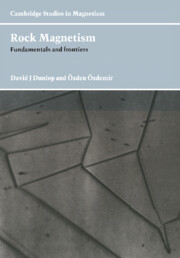Book contents
- Frontmatter
- Contents
- Preface
- Chapter 1 Magnetism in nature
- Chapter 2 Fundamentals of magnetism
- Chapter 3 Terrestrial magnetic minerals
- Chapter 4 Magnetostatic fields and energies
- Chapter 5 Elementary domain structures and hysteresis
- Chapter 6 Domain observations
- Chapter 7 Micromagnetic calculations
- Chapter 8 Single-domain thermoremanent magnetization
- Chapter 9 Multidomain thermoremanent magnetization
- Chapter 10 Viscous and thermoviscous magnetization
- Chapter 11 Isothermal magnetization and demagnetization
- Chapter 12 Pseudo-single-domain remanence
- Chapter 13 Crystallization remanent magnetization
- Chapter 14 Magnetism of igneous rocks and baked materials
- Chapter 15 Magnetism of sediments and sedimentary rocks
- Chapter 16 Magnetism of metamorphic rocks
- Chapter 17 Magnetism of extraterrestrial rocks
- References
- Index
Chapter 6 - Domain observations
Published online by Cambridge University Press: 06 July 2010
- Frontmatter
- Contents
- Preface
- Chapter 1 Magnetism in nature
- Chapter 2 Fundamentals of magnetism
- Chapter 3 Terrestrial magnetic minerals
- Chapter 4 Magnetostatic fields and energies
- Chapter 5 Elementary domain structures and hysteresis
- Chapter 6 Domain observations
- Chapter 7 Micromagnetic calculations
- Chapter 8 Single-domain thermoremanent magnetization
- Chapter 9 Multidomain thermoremanent magnetization
- Chapter 10 Viscous and thermoviscous magnetization
- Chapter 11 Isothermal magnetization and demagnetization
- Chapter 12 Pseudo-single-domain remanence
- Chapter 13 Crystallization remanent magnetization
- Chapter 14 Magnetism of igneous rocks and baked materials
- Chapter 15 Magnetism of sediments and sedimentary rocks
- Chapter 16 Magnetism of metamorphic rocks
- Chapter 17 Magnetism of extraterrestrial rocks
- References
- Index
Summary
Introduction
In the last fifteen years, there has been a resurgence of interest in observing domain patterns on naturally occurring minerals, as well as a revolution in ideas about how the observed structures control magnetic properties. The strained surface layer that results when sections are mechanically polished for domain observations by the Bitter method can now be efficiently removed by final polishing with a suspension of amorphous silica microspheres (Hoffmann et al., 1987). The previously used method, ionic polishing, required many hours' exposure to an ion beam and still failed to remove the stressed layer completely. Surface domains can also be observed using the scanning electron microscope (SEM), whose greater depth of field eliminates the need for precision polishing. The interior of domains and crystals can be imaged directly with the transmission electron microscope (TEM) and the magneto-optical Kerr effect (MOKE). The magnetic force microscope (MFM) provides the ultimate in spatial resolution, allowing us to view fine structures, e.g., the structure of domain walls.
Traditional Bitter-pattern observations use a colloidal suspension of ultra-fine magnetite particles to make visible the walls between domains, where flux leakage from the surface is maximum. These observations will be discussed in §6.2–6.6. SEM, TEM, MOKE and MFM observations are described in §6.7–6.9.
The observation of domains in minerals of paleomagnetic interest, in the ≈ 1μm grain sizes that probably carry the strongest and most reliable NRM in rocks, coupled with direct magnetization measurements on the same domains (e.g., Metcalf and Fuller, 1987a), should soon establish a direct link between the magnetic response of a rock sample and the nature of the domains responsible.
- Type
- Chapter
- Information
- Rock MagnetismFundamentals and Frontiers, pp. 144 - 170Publisher: Cambridge University PressPrint publication year: 1997



